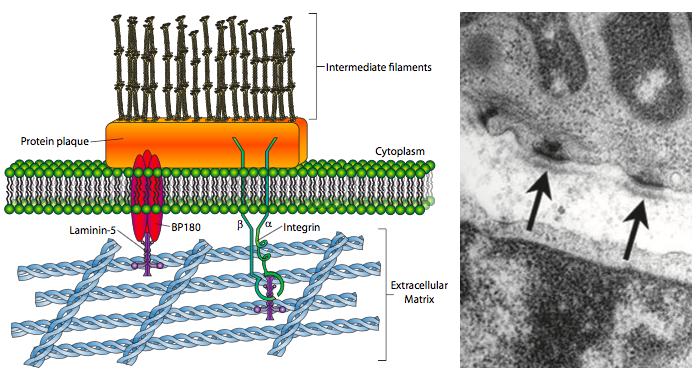13.7: Hemidesmosomas
- Page ID
- 53431
Los hemidesmosomas, particularmente aquellos que unen células epiteliales a su membrana basal, son las interacciones adhesivas más estrechas en el cuerpo de un animal. Este contacto cercano, y la estructura reforzada de estos contactos, es crucial para la resiliencia protectora de las capas epiteliales. ¿Recuerdas la integrina α6β4? Ese sería el que enlaza con filamentos intermedios en lugar de f-actina. Los filamentos intermedios, como ya hemos señalado, no son dinámicos, sino casi tan estables como puede ser un componente celular. También son muy fuertes y se utilizan para reforzar la integridad celular. Entonces, no es de sorprender que los filamentos intermedios y la integrina α6β4 desempeñen papeles en los hemidesmosomas.

Sin embargo, la característica distintiva de los hemidesmosomas es la placa densa de electrones. Puede pensarse como refuerzo para que cuando se estire el epitelio, la célula no solo se suelte dejando atrás parte de su membrana. La placa contiene varias proteínas, pero el componente primario son las plectinas, las proteínas enlazadoras que ayudan a agrupar filamentos intermedios, y los conectan entre sí así como con otros elementos citoesqueléticos. Otro elemento importante de las placas es BP230, que conecta la placa a la queratina. En el lado extracelular, además de la integrina ya mencionada, también existe una glicoproteína transmembrana llamada BP180, que también se une a elementos laminina de la membrana basal.
BP230 y BP180 se denominan penfigoide ampolloso, el trastorno bulloso subepidérmico caracterizado por ampollas crónicas de la piel. Se trata de un trastorno autoinmune y en el que la respuesta aberrante de anticuerpos es frente a estas dos proteínas hemidesmosómicas.

